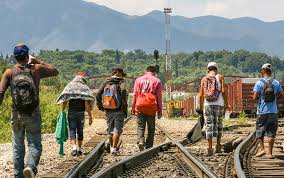Shelters that provide food, legal and medical aid to tens of thousands of migrants are subject to health laws that have forced some too close to stem the pandemic.
Dozens of migrant shelters in Mexico have closed their doors or scaled back operations in recent weeks to curb the ravages of coronavirus, exposing people to greater peril just as migration from Central America to the United States is on the rise again.
Reuters spoke to people responsible for over 40 shelters that had offered refuge to thousands on a route where immigrants without legal documentation often face assaults, robberies and kidnappings—before the pandemic forced them to shut or limit capacity.
The closures are a fresh headache for migrants already coping with reductions to the southern routes of a Mexican cargo train known as “La Bestia” (The Beast) that has long helped them get north.
Fewer shelters mean fewer safe places for Central Americans to take cover, even as many walk hundreds more miles than before, over a dozen migrants told Reuters.
When the main shelter in the northern city of Saltillo, a busy staging post on the road to Texas, shut before Christmas due to a COVID-19 outbreak that killed its founder, dozens of migrants were left to camp on the sidewalk outside.
Alarmed by the prospect of gangsters who often prey on migrants in the city, an important transit point for violent drug gangs, they organized their own night patrol.
“At night, suspicious cars park nearby or circle the area with two or three men inside,” said Honduran migrant Michael Castaneda, 27, who helped organize the sentry. “We know the gangs are watching us, and they know we’re watching them.”
A network of privately funded shelters provides food, legal and medical aid to tens of thousands of migrants traversing Mexico each year. Run by non-governmental agencies or religious organizations, they are subject to government rules, including health laws that have forced some to close in the pandemic.
Castaneda wants to reach the United States to work and send money back to his parents and three younger siblings to rebuild their family home, which was hammered by two devastating hurricanes that hit Central America in November.
But his journey across Mexico has been slow, he said, after he injured his leg en route and could not access medical care or rest properly because of shuttered shelters.
Estimates vary over how many shelters there are, but a 2020 study by bank BBVA Bancomer identified 96 shelters, rest houses and canteens for migrants on Mexico’s main migration routes.
The mounting risks Castaneda and other migrants face could complicate Mexican-U.S. efforts to improve their lot under the incoming U.S. president, Joe Biden, who has pledged to pursue more humane policies than the incumbent, Donald Trump.
Biden’s inauguration on Jan. 20 and the two hurricanes have already encouraged some Central Americans to head north. Social media chats used by migrants say a major migrant caravan is organizing to depart Honduras on Jan. 15.
The number of Hondurans, Guatemalans and Salvadorans caught trying to cross the U.S. border rose more than three-fold between July and November, U.S. official data show.
Exhaustion
In the southern town of Tenosique, a gathering point for migrants entering Mexico from Guatemala, an influential shelter known as “The 72” had to close its doors to new arrivals after a coronavirus outbreak there at the end of November.
“It’s a shame not to allow people into the shelter because that’s what we’re here for, especially in such a difficult moment,” said director Fray Gabriel Romero.
Before he began turning migrants away, Romero said he had been taking in Central Americans who had lost their homes and livelihoods to Hurricanes Eta and Iota in November. Even now, dozens of migrants continue arriving every day, he says.
In Saltillo, concerned residents shared hot plates of tamales with migrants on Christmas Eve, and the city has improvised to cope with the loss of shelter accommodation.
Longtime resident Glenda Troches, a Honduran, has opened her modest wooden home to migrants, well aware of the dangers they face, having once been kidnapped by a gang herself.
Troches is offering refuge to compatriots like Sara Servellon, a 32-year-old who left Honduras for the United States with her husband just as Eta was closing in.
By then, gang violence, a lack of work and the pandemic had convinced them they had no future in Honduras, Servellon said.
Still, she was so tired from the trek across southern Mexico that upon trying to climb aboard the “La Bestia” en route to Saltillo, she fell face first and passed out, she recalled.
“I was so weak,” she said.
They pressed on quickly though.
Before reaching Troches’ makeshift migrant refuge, Servellon said she had not slept safely in a shelter since the southern town of Palenque, more than 1,000 miles away.
“We’d walked across practically all of Mexico,” she said, “and we hadn’t eaten all day or night.” (Reuters)






































